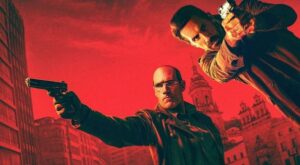Diablo is a gripping cinematic journey that follows five central characters, each navigating a fragmented reality shaped by secrets, illusions, and personal truths. As the narrative unfolds, the viewer is drawn from passive observer into the minds and emotional landscapes of these individuals each one trapped in their own version of reality.
The film is masterfully directed by Ernesto Díaz Esteban, who delivers what is arguably the pinnacle of his career to date. Known for a string of remarkable works that have steadily built his reputation, Esteban’s artistic evolution is evident when tracing the chronology of his filmography. Each release has marked a step forward in narrative depth, visual sophistication, and emotional resonance. With this latest project, he not only refines his signature style but also pushes the boundaries of his storytelling, cementing his place among the most compelling voices in contemporary cinema.
The film was supposed to be shot in the Republic of Chile, where director Ernesto Esteban and the character El Corvo (Marko Zaror) are from. When the filming location changed, the film crew had to adapt to include a new Colombian stunt team (Legionarius) and actress Alanna de La Rossa, who plays Elissa. The change of location forced the film crew to adapt the script to the new locations, and the viewer will not be disappointed, as the city of Bogota was the setting for a film full of thrills and twists, right up to the final scene.
The film’s director completes the cast of the film’s pillars with Kris (played by English actor Scott Adkins), who portrays the human thief; Vincent (Lucho Velasco), the lawless man and finally Judah played by Jason Gurvitz.
Scott Adkins delivers a compelling performance as Kris, a character defined by restraint and internal struggle. One of Adkins’ key challenges was crafting a fighting style that aligned with Kris’s personality: defensive, reactive, and deeply human. He rises to the occasion with precision, ensuring every move feels authentic and emotionally grounded. Kris rarely initiates violence, instead responding with calculated defense, and Adkins embodies this with remarkable control and synchronicity.
Throughout the film, Adkins conveys the weight Kris carries in his moral boundaries, his fear, and his quiet desperation. The audience remains emotionally tethered to him, sensing the tension and ethical line he refuses to cross: Kris is a thief, not a killer. In portraying this fragile balance, Adkins reveals a nuanced and powerful performance that resonates long after the final scene.
Marko Zaror delivers a standout performance as El Corvo, embodying a sinister, sadistic nature with chilling precision. It’s arguably his most compelling portrayal in a dark role, marked by ruthless intensity and emotional detachment. His mastery of facial expressions and physicality especially the character’s distinctive gait adds depth to the menace. In combat scenes, Zaror enhances El Corvo’s brutality by incorporating a military-style weapon mounted at hand level, designed to disembowel opponents, amplifying the character’s lethal presence.
The choreography of the film was directed by Marko Zaror, his immense knowledge in the field of choreographic design offers the viewer long satisfying scenes, moreover thanks to the experience of Ernesto Diaz Espinoza and the director of photography Niccolo de la fere, the fight sequences are very pleasant sequences to watch.
Among the action movies of the year 2025, the film Diablo stands out from the others by a story that keeps the audience curious until the end, finding the right way to place the right piece of the puzzle each time to have the complete picture only in the final scene. Through shifting perspectives and layered storytelling, the film gradually builds toward a volatile convergence, where all paths collide in a chaotic and emotionally charged confrontation. In this climactic moment, the illusion shatters, revealing a powerful truth: nothing lasting, nothing real, can ever be built on deception.
In conclusion, Diablo immerses the viewer in the vibrant yet shadowed streets of Bogota (capital of Colombia) where the film’s gripping story of a kidnapping unfolds. Shot on location, the city itself becomes a character, its alleys, street, and urban chaos reflecting the tension and emotional stakes of the narrative. Beyond the city limits, select scenes were filmed in the surrounding countryside, offering breathtaking visuals that contrast the urban grit with raw natural beauty. These sequences are elevated by the cinematic mastery of director Ernesto Díaz Espinoza and action star Marko Zaror, whose long-standing collaboration has honed a cinematic technique that blends realism with stylized intensity. Together, they deliver a film that is not only technically masterful but emotionally resonant, capturing the pulse of a city and the unraveling of truth.

